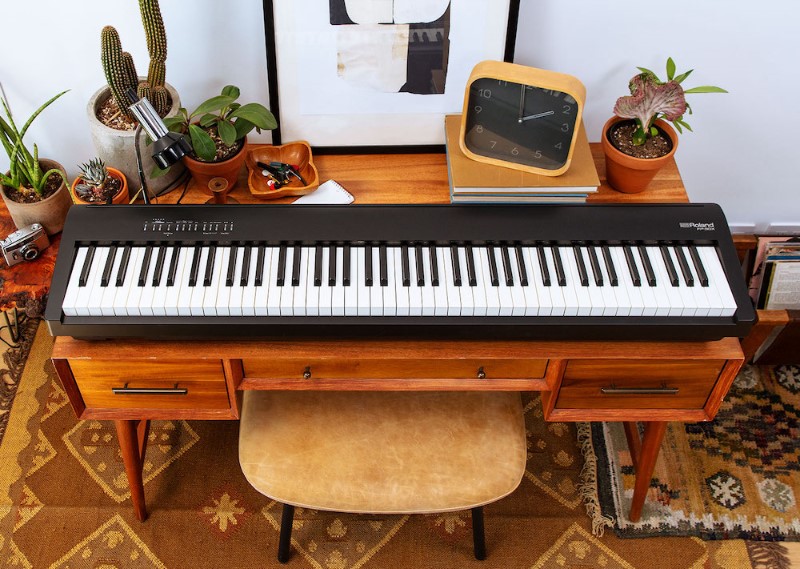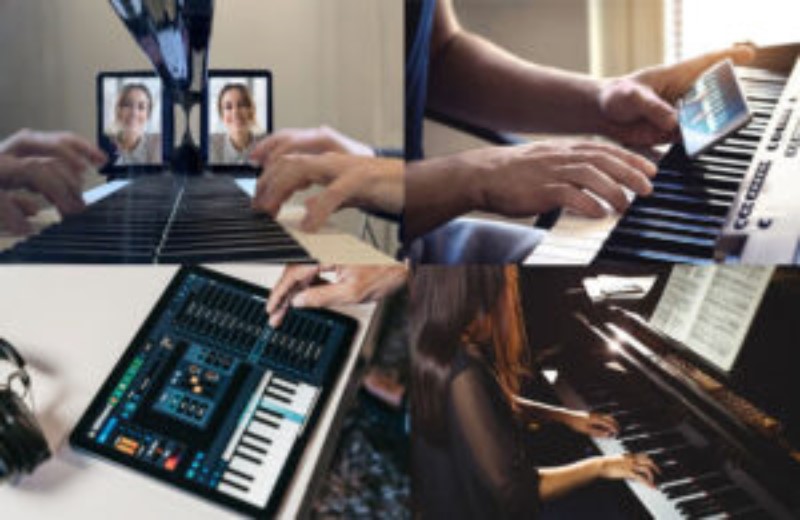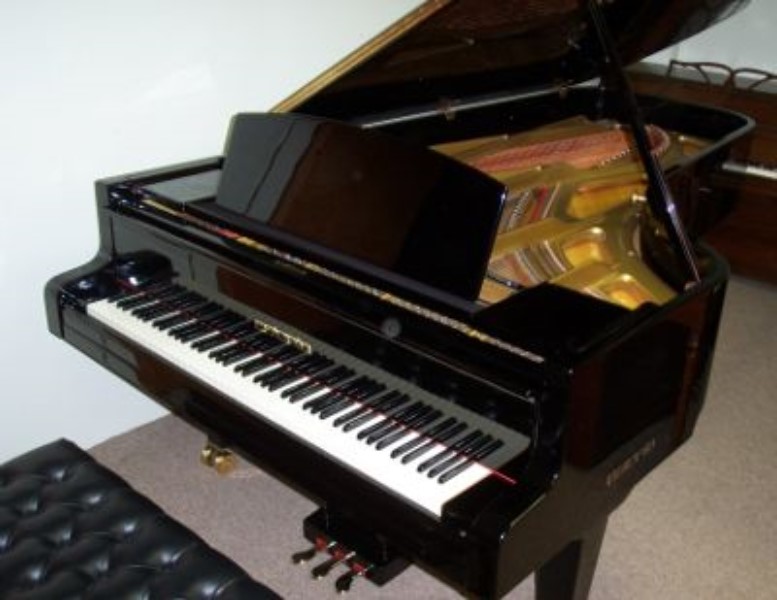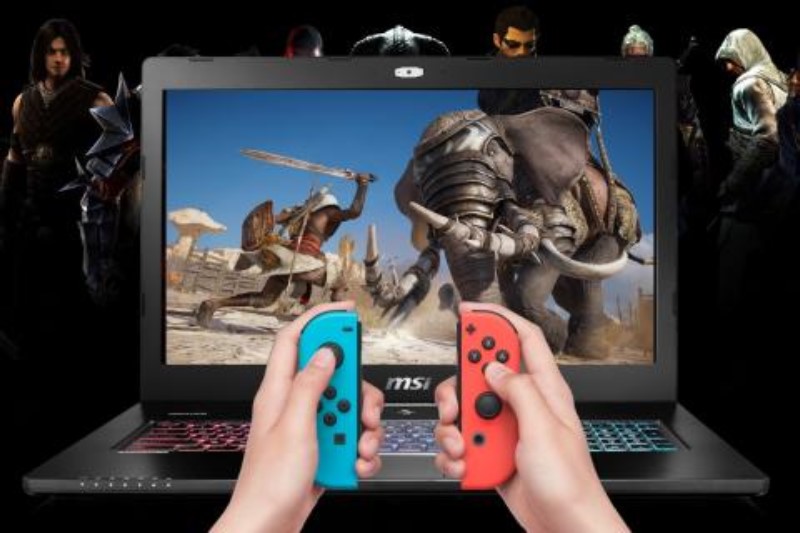

Would you like to learn to play the piano but don’t have one handy? Don’t worry! We have the solution for you: a virtual piano. Yes, you read that right, a piano on your computer or mobile device. This virtual instrument is a perfect tool for those who want to learn to play, but don’t have access to a real piano.
Even if you are already an experienced pianist, a virtual piano can be a very useful tool for rehearsing, composing and even recording your own songs. With a virtual piano, you can experiment with different sounds and settings, and do it all from the comfort of your own home.
Can you imagine being able to take your piano with you anywhere? Well, with a virtual piano this is possible. Whether you’re on the road or in the office, you’ll always have access to your instrument. Also, you won’t have to worry about the space that a real piano takes up.
So do not expect more! Discover all the advantages that a virtual piano can offer you and immerse yourself in the wonderful world of music.
The best virtual pianos for beginners

If you’re new to music and want to learn to play the piano, but don’t have access to an acoustic or digital piano, a virtual piano is a great option. Virtual pianos offer an affordable and practical alternative to learning to play the piano from the comfort of your home.
Features you should consider
When it comes to choosing a virtual piano for beginners, there are several factors to consider before making your purchase. Among them are the number of keys, sound quality, touch sensitivity and connectivity to mobile devices or computers.
The best virtual pianos for beginners
There are many virtual piano options on the market, but some of the best ones for beginners include the Yamaha P-45, Casio Privia PX-160, and Korg B1SP. These pianos boast beginner-friendly features like weighted keys, realistic sound, and connectivity to mobile devices or computers.
A virtual piano is a great option for beginners who want to learn to play the piano and don’t have access to an acoustic or digital piano. By considering the features of the virtual piano, choosing a quality brand, and connecting it to your mobile device or computer, you can get an enriching music learning experience from the comfort of your home.
How to choose the right virtual piano for your needs

When choosing a virtual piano, it is important to take into account several aspects that will help you find the right one according to your needs. Below are some of them:
Sound quality and simulation of an acoustic piano
Sound quality is essential for a virtual piano, since its main purpose is to simulate the experience of playing an acoustic piano. Therefore, it is important to look for one that has a good simulation of the sound of an acoustic piano, especially if you are an experienced pianist.
Keyboard
The keyboard is one of the main components of the virtual piano, therefore it is important to take into account its quality, size and number of keys. Keyboards with weighted and velocity-sensitive keys are ideal for a more realistic experience.
Additional functions and features
In addition to the quality of the sound and the keyboard, it is important to consider other additional functions and features that virtual pianos can offer, such as the possibility of recording and playing back your performances, compatibility with different devices or music programs, among others.
Taking these aspects into account, you will be able to choose the virtual piano that best suits your needs and expectations, whether you are just starting to play the piano or you are an experienced pianist looking for a more realistic experience.
The advantages of learning to play the piano with a virtual piano

Learning to play the piano is an awesome skill that can provide many benefits. A virtual piano can be a great tool to help beginners learn to play the piano for many reasons.
Effective cost
Acoustic pianos can be very expensive and require a lot of maintenance. Virtual pianos are a more affordable and accessible alternative. You don’t have to spend thousands of dollars on an expensive instrument to start learning. Virtual pianos have a wide range of pricing options, making them affordable for all budgets.
practice options
Virtual pianos offer many practice options that are hard to find on acoustic pianos. Virtual pianos have a wide variety of built-in sounds and rhythms that can be used during practice. They can also record and play back the music being played, which helps students hear what they are doing and gauge their progress. Also, virtual pianos are quieter than acoustic ones, meaning people can practice late at night without disturbing neighbors or family members.
Portability and accessibility
Virtual pianos are highly portable and can be taken anywhere, making them a great choice for people who travel frequently. Additionally, virtual pianos can be connected to a computer or mobile device for a more personalized experience. They are also more affordable than acoustic ones, since they can be found in a wide variety of online or physical stores.
The differences between a virtual piano and an acoustic piano

Sound quality: The main difference between a virtual piano and an acoustic piano is the sound quality. While an acoustic piano produces an organic sound, a virtual piano produces a digitized sound. The sound quality of a virtual piano will depend on the quality of the speakers used and the sampling technology used to create the sounds.
Feeling of touching: Another important difference is the feeling of playing. An acoustic piano has mechanical keys that offer a unique tactile experience. A virtual piano, on the other hand, has keys that are not connected to strings and do not offer the same tactile feel as an acoustic piano. Some virtual pianos offer weighted action keys to simulate the feel of playing an acoustic piano.
Maintenance and cost: An acoustic piano requires a lot of maintenance, such as regular tuning adjustments and repair of mechanical parts. Also, an acoustic piano is much more expensive than a virtual piano. A virtual piano, on the other hand, is maintenance free and much more affordable.
In conclusion, both virtual and acoustic pianos have their advantages and disadvantages. The choice will depend on the individual needs and preferences of each person. It’s important to consider sound quality, playing feel, and cost before making a decision.
The best brands of virtual pianos on the market

When buying a virtual piano, it is important to know which are the most recommended brands to obtain a quality instrument. Mentioned below are some of the most popular and recognized brands on the market:
yamaha
The Japanese brand Yamaha is one of the most popular in the manufacture of pianos, both acoustic and virtual. Its line of digital pianos is renowned for its high sound quality and its wide variety of models for different skill levels. In addition, its virtual pianos have technology that allows a playing experience very similar to that of an acoustic piano.
Casio
Casio is another well-known brand in the virtual piano market. Its models stand out for their ease of use and their additional functions, such as the ability to record and play music or the possibility of using headphones for a quieter practice. Also, their virtual pianos often have a very competitive price.
Kawaii
The Japanese brand Kawai is renowned for its high sound quality and hammer action keyboards, which offer a playing experience very similar to that of an acoustic piano. Their models have a wide variety of sounds and additional functions, such as sound effects and the possibility of connecting the piano to a computer to use music production programs.
In summary, these are just some of the most recognized brands in the virtual piano market, but there are many other options available on the market. The important thing is to find a piano that suits your needs and budget, and that offers a playing experience as close as possible to that of an acoustic piano.
How to connect a virtual piano to your computer or mobile device

Connecting your virtual piano to a computer or mobile device is essential to be able to use programs and applications that allow you to improve your skills and record your performances. Here are the basic steps to connect your virtual piano:
USB connection
The most common way to connect a virtual piano to a computer or mobile device is through a USB cable. To do this, you simply need a USB cable and an available connection on your device. Plug the USB cable into your virtual piano and into your device and make sure it is properly connected. If your device recognizes the virtual piano, you can start using it in your programs and applications.
MIDI connection
Another option is to connect your virtual piano through a MIDI connection, which allows greater flexibility and customization in terms of control possibilities. You will need a MIDI cable and a MIDI interface that suits your device. Plug the MIDI cable into your virtual piano and into the MIDI interface, and the latter in turn to the device. It is important that you set up the MIDI connection on your device so that it can recognize the virtual piano and its functions.
Connecting your virtual piano to a computer or mobile device doesn’t have to be a complicated task. If you follow the proper steps and set up the connection correctly, you can start using your virtual piano in your favorite programs and applications.
How to use a virtual piano to improve your music composition skills

A virtual piano is a useful tool for those looking to improve their music composition skills. With a virtual piano, you can create and experiment with different arrangements and melodies. Here are some tips on how you can use a virtual piano to enhance your musical creativity:
Experiment with different musical styles
A virtual piano allows you to experiment with different musical styles. Don’t limit yourself to just one music genre. Try different tonalities and rhythms. Listen to different types of music and try to imitate them using the virtual piano. You can also use different sound effects to give your compositions a unique touch.
record your compositions
One of the advantages of using a virtual piano is that you can record your compositions. This allows you to listen to your creations over and over again to improve and refine them. You can also share your creations with other people to get feedback and advice.
Use music editing programs
There are many music editing programs available on the market that you can use to improve your compositions. These programs allow you to adjust the pitch, speed, and length of your melodies. You can also add sound effects and change the instruments used in your compositions. Learn to use these programs and experiment with different options to improve your music composition skills.
